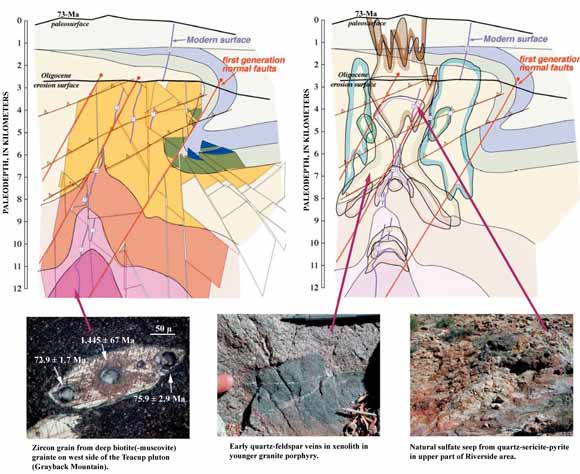

|

Preliminary reconstruction of 73-Ma Grayback (Teacup)-Kelvin-Riverside intrusive center and hydrothermal system (contributions by instructors and students in the 2002 Educational Component at the National Cooperative Geologic Mapping Program [EDMAP] at the University of Arizona, Tucson). |
|
Fiscal year 2002 was the first feasibility-study year of a U.S. Geological Survey (USGS)-University of Arizona (Center for Mineral Resources) joint project, titled "Porphyry Copper Deposit Life Cycles-a Regional Approach." Early results, progress, and some planning from the project work to date were illustrated at sites in the Tortilla-Dripping Spring-Pinal Mountains area during the field conference (fig. 1-1). We also visited the study sites of scientists of the USGS Water Resources Discipline, who have been working in the Miami-Globe area for more than a decade. The purpose of this field conference was threefold. The first purpose was to share among the participants our research and thinking since the official start of the project on October 1, 2001. The first day emphasized the genesis of porphyry copper deposits and their geologic context; the second day focused more on the effects, both local and regional, of mining and processing. The second purpose was to increase collaboration among parties in academia, the USGS, and the mining industry, as well as other stakeholders. The third, and most important, purpose was to obtain suggestions and advice from all participants in order to aid in creating a continuing proposal that will form the basis for research throughout the lifespan of the project. During this conference, participants were asked to consider several questions that may govern the future course of the project: What are the important scientific questions that, if answered, will have a significant, positive effect on our understanding of the life cycles of porphyry copper and related deposits? Which of these questions, if answered, could have a positive effect on society? Where can we best focus our efforts for maximum effect, given the 5- to 6-year lifespan of the joint project, limited funding, and the expertise of project participants? On what questions can we effectively collaborate with mining companies? |
Download this report as a 50-page PDF file (17.9 MB)
For questions about the content of this report, contact Mark Barton, U of A or Bob Kamilli, USGS
|
Help |
PDF help |
Publications main page |
This report is available only on the Web
URL of this page: https://pubs.usgs.gov/sir/2005/5020/
Maintained by: Michael Diggles
Created: January 9, 2006
Last modified: January 9, 2006 (mfd)